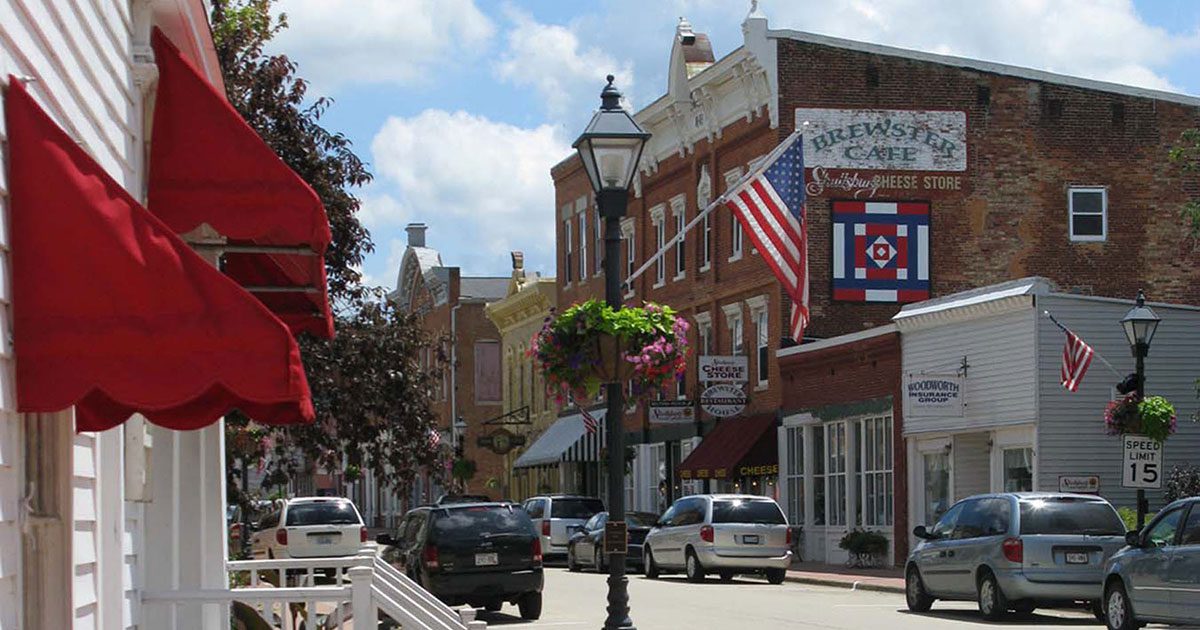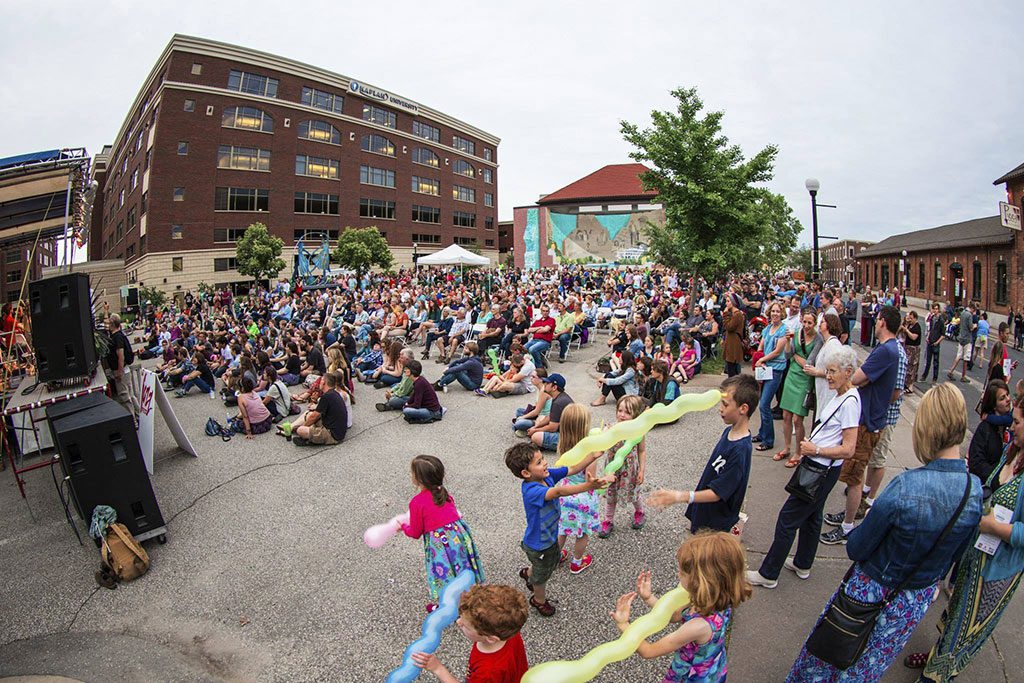
One of the joys of spring in Wisconsin is the start of farmers market season.
Farmers markets are important to communities in many ways. They are a critical component in rebuilding local food economies. They provide a cost-effective, retail sales opportunity for local food producers, and often for artisan businesses as well. And they are a beloved social gathering place for many Wisconsinites. But as the nation begins to emerge from the pandemic and farmers markets begin to welcome groups of consumers—some of whom may be returning for the first time in more than a year–it’s important to plan socially responsible strategies. You can check out the most up-to-date USDA guidelines here.
These three ways to help these markets succeed are: adopt conscious placemaking efforts, employ effective marketing strategies, and offer alternative market options.
Placemaking for farmers markets

People who flock to farmers markets care about the locally grown produce and other foods, but another reason they enjoy the markets is for the atmosphere and the fun. Even with pandemic-related considerations, organizers can create a special experience for visitors. Surveys of several Wisconsin farmer and artisan markets show that the longer customers linger, the more they tend to spend. Typically, customers will make a first round through the market to see what’s available and then a second pass to buy the items they’ve chosen. However, markets that can give customers cause to pause even longer—such as a pleasant environment and enticing activities—often can capture additional “third-pass” spending.
How can markets encourage customers to linger safely? The emerging field of placemaking or creating connections between people and the public spaces where they want to congregate, offers some ideas. Here are elements that can help turn a public space into a “place”:
- Someplace to rest (benches or seats)
- Something to eat (Markets have this in abundance!)
- Something to watch (such as fountains or performers)
- Something to do (activities)
Regardless of a market’s location, managers can make any number of improvements to the market area to incorporate these elements in a safe and socially distanced manner.
Someplace to rest:
A place to rest is important for people who want to take a break from shopping, sample their purchases, people-watch, or just enjoy their surroundings. Before COVID, Future Omro moved picnic tables from a nearby park and set them under a tree near the market to encourage customers to have a meal together at the market site. The Whitewater City Market provided Adirondack chairs for guests to sit and chat, strategically placed near the children’s area, which was equipped with chalk and bubbles for youngsters to play with. Even now, movable seating can allow family groups to sit together while they keep a distance from others, and individual or disposable utensils can still be made available.
Something to eat:
While all farmers markets offer plenty of edible goodies, encouraging vendors to offer samples provides both an enticement for customers to visit and sends mouth-watering smells throughout the area, which also can stimulate purchases. In order to be respectful of health and safety, vendors can easily adapt any tastings to offer single-serving samples instead of the typical open plate offering.
Something to watch:
Many markets have musical performers, and they can add to the ambiance. However, they may not always be positioned in an area where customers can linger to watch. Locating performers near seating areas lets customers take a break from shopping and enjoy the music. If your market happens to be in a park, seats near a fountain or a body of water can have a calming effect. For evening markets, especially in spring or fall, fire pits surrounded by seats can set a good mood and perhaps even lead to additional dining opportunities.
Something to do:
Low-cost activities can be added to attract people of all ages, such as the watermelon explosion challenge, where more and more rubber bands are wrapped around a watermelon until the pressure of the bands makes the melon explode. Market organizers might stage pie eating, taste testing or other contests that are fun for both participants and spectators. Even when attendance is spaced to reduce crowd size, events can be recorded on video for social media marketing purposes. Beyond contests, there are plenty of distanced activities that can be offered at a farmers market, including individually packed craft kits for kids to build at the market or at home; spinning a wheel to hold prize drawings; or demonstrations of cooking or other skills. If your market is in a business district, you can involve nearby businesses by offering coupons or tokens to encourage same-day purchases, which is another way to prolong visits to the market and to capture additional spending.
All of these elements work together to create a place where people will choose to gather. With planned activities, people will spend more time at the farmers market and often will spend more money.
Marketing for farmers markets
Marketing is an important aspect of your farmers market plans. Creating a solid marketing strategy is essential in order to attract more customers, increase the number of return visits, and to capture more spending from each market patron.
Whether or not you have a marketing manager or marketing budget, you can find ways to draw customers to your market effectively. You do not need to spend tens of thousands of dollars, but you do need to invest time, and that can include rounding up volunteers, community partners, and vendors to participate. You can match volunteers with their interests, such as asking photography buffs to take photos at the market or having volunteers interview market vendors on social media. While vendor fees can pay for basic marketing tools such as signs or social media sponsored posts, if you line up market sponsors, those organizations or businesses can provide funds or grants to pay for printed materials, equipment or even a pop-up tent for an information booth.
To create the most effective marketing strategy for your farmers market, your playbook should include advertising, outreach, promotions and social media. All of these elements can work together to create a plan that will best achieve your goals for your market.
Marketing
Marketing refers here to paid advertising, which is the foundation of your marketing strategy. Marketing materials can include print or radio ads; rack cards or posters; mailings or newsletters; and signs, billboards and banners. It would be best to start with one or two of these elements that are most likely to reach your target audience. While each of these options has its benefits, during the climate of the pandemic, radio ads, print ads, and newsletters are the most important marketing elements. Before COVID, rack cards and sandwich boards displayed at tourist locations were likely the best way to get the word out. More recently, with travel greatly reduced, print ads are more effective as potential visitors read local publications, and radio commercials can be aired when people are most likely to be listening. Your ad content should always help engage your customers and work hand-in-hand with the rest of your marketing strategy.
Outreach
Outreach refers to tactics that encourage the community to promote the market. Time is vastly more important than money to connect with residents of your area. You do not need a paid manager or marketing person to promote your market through outreach. While market organizers may no longer be able to set up a booth at a local event, festival or parade because of COVID restrictions, vendors and volunteers can attend Zoom meetings at schools, organizations and group meetings, participate in the social media accounts of local businesses, or host Facebook Live events. The most important part of outreach is that representatives of your farmers market have a presence out in the community, whether that be physically or virtually.
Promotions
Promotions refers to marketing that is word of mouth–often the most powerful form of marketing. This includes features, events, incentives and partnerships.
- Features are recurring activities that are set up regularly as an integral part of your market. The point of a feature is to give your customers something to talk about. That could involve a weekly performance by a popular musical group, activities for children or cooking demonstrations. Although some of these activities cannot be offered in the same manner as they were before, they can all be altered to adhere to COVID safety guidelines for your specific space constraints.
- Events can include specific celebration days—such as plant day, cat adoption day or recycling day. In addition to holding an event, giving people something to talk about will help encourage them to make plans to come to the event. You can provide printed marketing materials to volunteers who can promote the event as they talk to customers. For example: If you want to promote Plant Day, set up a sandwich board at the entrance to the market that says, “Next Saturday is Plant Day.” You can create a display with plants from different market vendors, and a volunteer can greet people and make sure they know that next Saturday is Plant Day.
- Incentives such as prizes, raffles, coupons, giveaways and rewards are a great way to promote your market through word of mouth. Everyone likes the idea of being a winner or getting something extra. Most incentives are easy and safe to offer, even during the pandemic.
For example: You can set up a “Market Mogul” e-newsletter. Visitors who sign up at the market will receive an email once a week listing the newly available produce along with any special events or shopper rewards at the market that week. Each vendor can get a turn featuring a reward and can offer it, for instance, to the first 30 customers who buy their products. Local businesses can play a role, as well, by sponsoring an incentive related to their industry.
- Partner organizations or businesses can provide market materials at their locations, host speakers about your market, and publicize the market’s events, features, and incentives to their employees.
Promotions are generally effective because they incorporate word-of-mouth methods. People hear about your market from friends, relatives or co-workers who may be viewed as a trusted source. With print advertising, marketing, and outreach, you are spreading word of your farmers market to a broader audience, but often, with a more general message. Promotional materials typically highlight current and upcoming activities at the market, keeping the market’s message fresh.
Social media
Social media is the digital version of word of mouth. Social media can incorporate all types of online communication, including Twitter, Facebook, Instagram and e-newsletters, with the goal of driving traffic to specific websites. Social media’s digital word of mouth offers another layer of access to people and is now more important than ever. A lot of the printed marketing materials can be translated into digital form and used to promote your events, features and incentives. Social media also can be the most cost-effective format for marketing.
With these four elements at play in the marketing strategy—paid advertising, community outreach, promotional events and social media messages–organizers will be able to achieve their marketing goals for their farmers market. Not only will you create ways for people to learn about your market, but you will enhance visitors’ experiences, prompting them to stay longer, come back for return visits, and spend more money.
Market alternatives

While farmers markets are wonderful attractions during the summer when the weather is nice, kids are out of school and people are looking for things to do, it is often difficult to sustain a farmer’s market year-round. Also, some communities may still be struggling to host farmers markets in person or at a larger scale, due to the pandemic. That is where some alternative types of markets can come into play, such as night markets, indoor farmers markets and virtual farmers markets.
Night market
A night market is a farmer’s market that is held in the evening and offers experiences that normally wouldn’t be available at a daytime farmers market. It is an opportunity for local businesses to stay open late, for merchants and farmers to socialize with customers of differing demographics and for visitors to have a unique experience in their community. Night markets also can incorporate local bands, local artists, food trucks, pop-up restaurants and other fun activities. It is a great way for people to come together safely and celebrate their community.
Indoor farmers market
An indoor farmers market is a way to bring local farm products to the community during the fall and winter months, in a covered setting that’s protected from the weather. You can use promotional tools from the summer farmers market to make sure customers know about the indoor market, and you can offer incentives, such as coupons, to help bring people indoors.
Virtual farmers market
The biggest drawback to a traditional farmers market is the limited window of opportunity to get to the event. Farmers markets usually are held for a few hours on a weekend day or one evening during the work week. In addition, some people may not feel safe attending a farmer’s market during the pandemic. This means that farmers’ locally grown products aren’t always accessible, which pushes people to do their produce shopping at supermarkets instead. Luckily, a new alternative to the traditional farmers market involves posting the market online and offering pickup and delivery services. With a virtual farmers market, the customer has more access to local produce and farmers have eager customers at any time.
Lulus Local Food is one way to start your virtual farmer’s market. Lulus Local Food provides an innovative software solution for operating online farmers markets and food hubs. The progressive program has been designed to serve as an online tool for establishing a local market food system. The growth of programs such as this may help pave the way for fundamental changes in the way locally grown food is bought and sold in communities around the country, including Wisconsin.
Examples:







